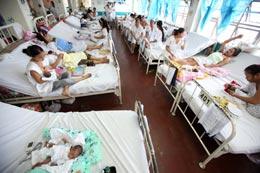4,775 babies born every day in The Philippines

The Philippines total population hit a milestone when it officially topped the 100 million mark on July 26, at 12:23 a.m. with the birth of a baby girl named Chonalyn at Manila’s Fabella Hospital.
To many in the Philippines, if not other parts of the world, Chonalyn’s birth – along with about 100 other babies almost simultaneously in Filipino hospitals and homes – is not necessarily cause for celebration.
The archipelago nation is now the world’s 12th largest country, ranking 35th of 238 countries or principalities in population density. That figure is deceptive, however. Much of the country’s land area of 298,170 sq km is on uninhabitable islands, making it one of the world’s most densely populated. The greater Manila conurbation, a collection of 17 cities, is ranked the 11th most populous in the world, with a density of 700 people per sq km, home to 25.5 million people, said a report in the Asia Sentinel.
The Philippines continues to have Asia’s highest total fertility rate at 3.15 except for Afghanistan, at a time when population growth for the rest of the region has stalled out and for many, including South Korea, Singapore, Thailand, Taiwan, Japan, Vietnam and all of China’s major cities, has fallen below the rate of 2.1 children per woman of childbearing age. That is the level at which population starts to decline. Currently 33.7 percent of the Filipino population is under the age of 14. More than half are under the age of 24 according to the CIA World Factbook.
The major hope for the country is that economic growth and the 2012 passage of the Reproductive Health Act mandating birth control devices and sex education in the schools can combine to slow population growth. There is anecdotal evidence that this is happening in the cities where families appear increasingly content to have one or two babies rather than the seven or eight that their rural parents produced. As economies grow more urban and richer, total fertility rates fall.
The Aquino administration has boosted the budgets for education, health care, cash transfers to the poor and other social spending programs, plus pushing the private sector to help fund major infrastructure projects. The economy has responded by metamorphosing into one of Asia’s fastest growing, even in the wake of devastating natural disasters including Typhoon Haiyan/Yolanda and a 7.2 magnitude earthquake that struck the central part of the country in October, devastating the Bohol area. Rating agencies such as Moody’s, Standard & Poor’s and others have upgraded the Philippines, meaning debt service is less onerous.
Fourth-quarter gross domestic growth was 6.5 percent according to the Asian Development Bank, bringing growth to 7.2 percent, well above the 4.7 percent average recorded from 2008 to 2012. Fixed asset investment increased by 11.7 percent, accelerating from 2012 and adding significantly to GDP growth. More importantly, the expansion, the ADB said, was driven by services, manufacturing, and construction as much as by business office processing, and inland remittances from the 10 percent of the population that remains overseas, working in the Middle East, the United States, and Hong Kong and Singapore.
But that doesn’t mean the country is on anything like an effortless path to economic wellbeing. It remains in dire straits. With per capita GDP by purchasing power parity of just US$4,400 annually, the Philippines ranks 165th in the world. In 2011, the National Statistics Office of the Philippines reported that 199 babies were being born every hour, or 4,775 per day.
It is a population growth rate that, if it continues, would make it nearly impossible to give a large segment of its population a life of anything besides dire poverty, given the problems of creating roads, schools, hospitals and other government infrastructure to keep up with population growth, especially in a country with a high corruption rate that ranks it 96th of 177 according to the Transparency International Corruption Perceptions Index, meaning a significant amount of expenditure is stolen.
The birth control bill is the country’s other significant accomplishment, and one that women say they desperately want despite the objections of the Catholic Bishops Conference. After a 14-year campaign by birth control advocates, President Benigno S. Aquino III in December 2012 found the political muscle to push through the Reproductive Health bill, which requires government health centers to hand out free condoms and birth control pills and sex education is to be taught in schools. It also requires that public health workers receive family planning training, while post-abortion medical care is also legalized. The court, however, struck down some provisions that were designed to punish and fine local health providers who refuse to disseminate information on birth control services and programs.
The bill was perhaps Aquino’s most important legacy so far in his four years in office. But a year and a half after its passage, it remains largely un-implemented. The measure faced a last-ditch campaign in the Philippine Supreme Court, which finally ratified it in April of this year – without some of the provisions of the RH law that the church hierarchy opposed.









